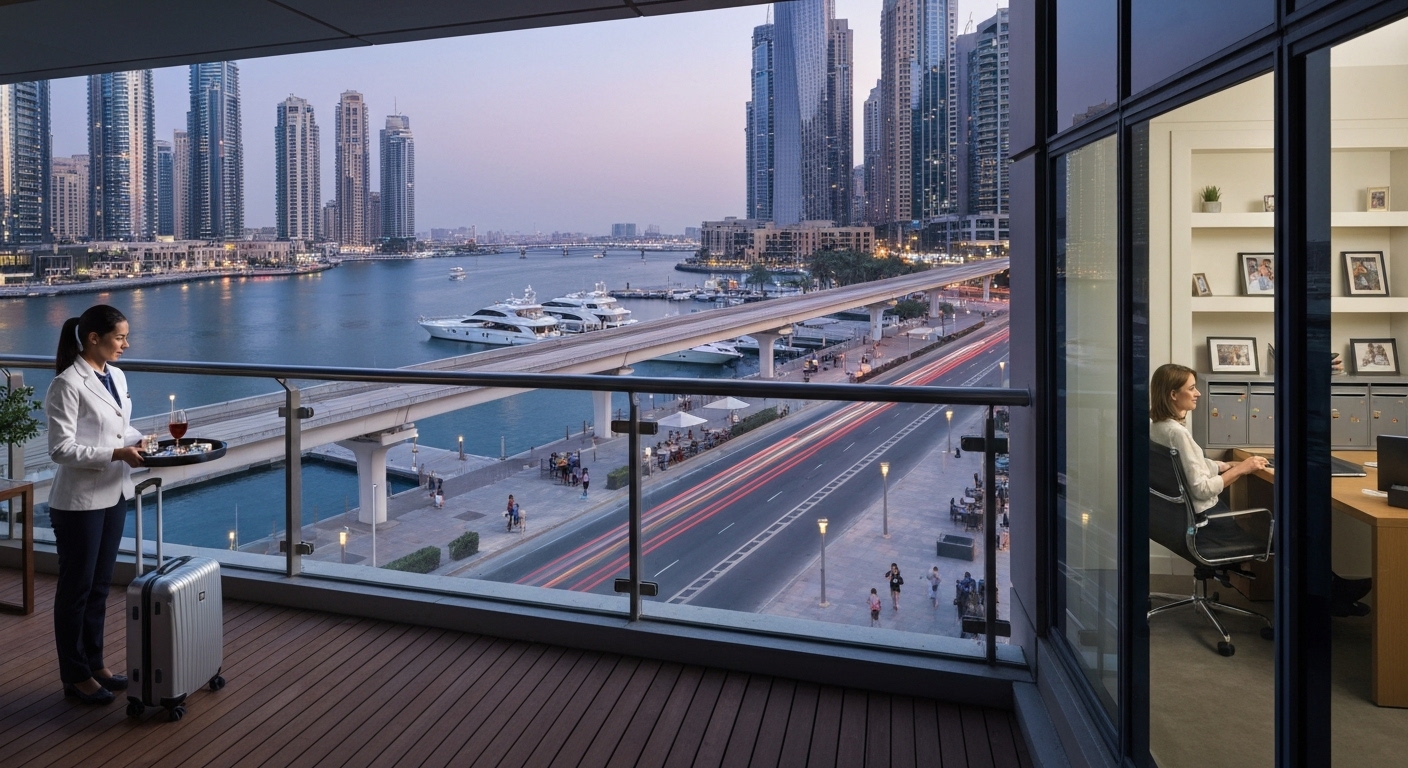Dubai Marina stands at the forefront of the city’s rental property market, and many investors want to understand the annual ROI for short-term vs long-term rental in Dubai Marina. In this guide, we give a data-driven comparison—so you can weigh the pros and cons of each approach and make informed decisions suited to your investment goals.
Understanding ROI in Dubai Marina’s Rental Market
Dubai Marina is consistently ranked among the top neighbourhoods for rental yield in the UAE, thanks to its waterfront lifestyle, global connectivity, and strong tenant demand. As of 2025, average gross rental yields in Dubai Marina are estimated at 6-7% annually, outperforming many global property markets. Yields fluctuate within this range depending on the property’s exact location, level of fit-out, and tenure—short-term vs long-term rentals each offer unique benefits and risks.
Short-term rentals (holiday lets, serviced apartments) can push gross yields towards the upper end of the 7% spectrum in strong tourist seasons, but long-term leases typically provide more stable annualised returns in the 5-7% range.
Short-Term Rentals in Dubai Marina: Advantages and Disadvantages
Short-term rentals have surged in popularity in Dubai Marina due to the area’s attractiveness to business travellers and tourists. These properties can command high nightly rates, especially near metro stops and waterfront attractions. Investors benefit from:
- Higher Income Potential: In peak periods, short-term lets may deliver annualised yields of 7–10% before expenses.
- Flexibility: Owners can enjoy personal use during vacancies or adjust pricing dynamically.
Still, this model comes with trade-offs:
- Operational Complexity: Frequent guest turnover means higher management costs for cleaning, maintenance, and marketing.
- Seasonal Volatility: Occupancy rates and nightly rents can fluctuate significantly, impacting realised returns.
- Regulatory Requirements: All short-term lets must observe Dubai’s holiday home regulations, which include registration and periodic inspections.
Long-Term Rentals in Dubai Marina: Stability vs. Potential
Long-term rentals remain a popular, low-hassle option for Dubai Marina investors keen on steady returns. Typical benefits include:
- Stable Tenancy: Most leases are for 12 months, lowering vacancy risk and reducing property wear-and-tear.
- Predictable Cashflow: Fixed monthly payments simplify financial planning, with average annual yields around 5–7%.
- Lower Management Burden: Fewer turnovers mean reduced expenditures on cleaning and tenant search.
However, investors may see lower peak yields compared to short-term models, and have less flexibility in adjusting rents within the lease term. Also, regulatory protections favour tenants, so regaining possession between contracts can involve delays in some circumstances.
Calculating Your Annual ROI: Key Metrics and Hidden Costs for Both Strategies
Real-World Example: Comparing ROI Scenarios
To determine the net annual ROI for rental properties in Dubai Marina, investors should account for both gross income and all operating expenses.
Short-term rental scenario: An apartment generates AED 180,000 a year at high occupancy and nightly rates. After management fees (15–25%), utility bills, cleaning, and periodic furnishing updates, total annual costs could reach AED 40,000–60,000. Net ROI might average 6–8%.
Long-term rental scenario: The same unit leases for AED 120,000. Deducting minor annual maintenance and agency fees (totaling AED 10,000–15,000), net ROI arrives at 5–7%.
Key expense categories for both models include service charges, property management fees, marketing, vacancy allowance, and—for short-term units—higher wear-and-tear.
Factors Influencing Short-Term vs. Long-Term Rental Profitability in Dubai Marina
Dubai Marina’s rental profitability is shaped by location within the neighbourhood (walkability to the Marina Walk, proximity to the metro), property size, and seasonal events. Short-term rental performance aligns closely with Dubai’s tourism flows—during Expo periods or winter holidays, short-term yields can temporarily spike. Long-term rentals fare better in market downturns, offering more predictable income in uncertain climates.
Regulatory Landscape and Management Considerations
Both leasing models operate within frameworks set by Dubai’s Real Estate Regulatory Agency (RERA) and the Department of Tourism and Commerce Marketing (DTCM). Short-term rentals must be registered and managed by licensed operators, adding to compliance costs. Managing a short-term let remotely is challenging, whereas long-term leasing is hands-off, especially when using trusted property managers.
Making the Right Choice: Which Rental Strategy Suits Your Investment Goals?
For investors seeking maximised short-term ROI and who can absorb seasonal income variations, short-term rentals may be attractive in Dubai Marina—especially for prime, furnished units. Those prioritising stability, lower workload, and consistent cash flow will likely prefer the long-term rental route. In Dubai Marina’s dynamic real estate market, both strategies offer robust fundamentals, with short-term rentals yielding up to 8% net in favourable periods and long-term lets delivering stable 5–7% annual returns. For tailored investment advice or to explore property opportunities that match your strategy, contact Danube Properties to learn more.




